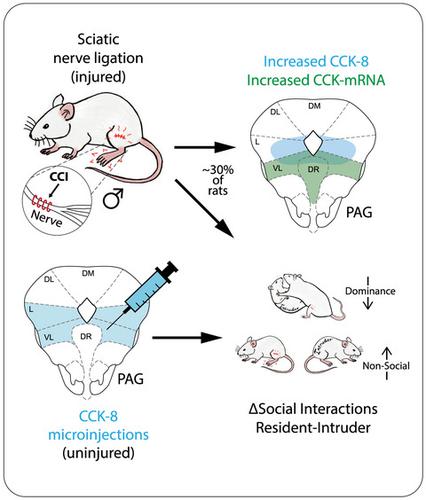当前位置:
X-MOL 学术
›
J. Neurochem.
›
论文详情
Our official English website, www.x-mol.net, welcomes your feedback! (Note: you will need to create a separate account there.)
Evidence that increased cholecystokinin (CCK) in the periaqueductal gray (PAG) facilitates changes in Resident–Intruder social interactions triggered by peripheral nerve injury
Journal of Neurochemistry ( IF 4.7 ) Pub Date : 2021-07-20 , DOI: 10.1111/jnc.15476 Kevin A Keay 1 , Manuel A Argueta 1 , Daniel N Zafir 1 , Peter M Wyllie 1 , Gregory J Michael 2 , Damien C Boorman 1
Journal of Neurochemistry ( IF 4.7 ) Pub Date : 2021-07-20 , DOI: 10.1111/jnc.15476 Kevin A Keay 1 , Manuel A Argueta 1 , Daniel N Zafir 1 , Peter M Wyllie 1 , Gregory J Michael 2 , Damien C Boorman 1
Affiliation

|
Individual differences in the effects of a chronic neuropathic injury on social behaviours characterize both the human experience and pre-clinical animal models. The impacts of these changes to the well-being of the individual are often underappreciated. Earlier work from our laboratory using GeneChip® microarrays identified increased cholecystokinin (CCK) gene expression in the periaqueductal gray (PAG) of rats that showed persistent changes in social interactions during a Resident–Intruder encounter following sciatic nerve chronic constriction injury (CCI). In this study, we confirmed these gene regulation patterns using RT-PCR and identified the anatomical location of the CCK-mRNA as well as the translated CCK peptides in the midbrains of rats with a CCI. We found that rats with persistent CCI-induced changes in social behaviours had increased CCK-mRNA in neurons of the ventrolateral PAG and dorsal raphe nuclei, as well as increased CCK-8 peptide expression in terminal boutons located in the lateral and ventrolateral PAG. The functional significance of these changes was explored by microinjecting small volumes of CCK-8 into the PAG of uninjured rats and observing their Resident–Intruder social interactions. Disturbances to social interactions identical to those observed in CCI rats were evoked when injection sites were located in the rostral lateral and ventrolateral PAG. We suggest that CCI-induced changes in CCK expression in these PAG regions contributes to the disruptions to social behaviours experienced by a subset of individuals with neuropathic injury.
中文翻译:

有证据表明导水管周围灰质 (PAG) 中胆囊收缩素 (CCK) 的增加促进了周围神经损伤引发的居民-入侵者社交互动的变化
慢性神经性损伤对社会行为影响的个体差异是人类经验和临床前动物模型的特征。这些变化对个人福祉的影响往往被低估。我们实验室使用 GeneChip® 微阵列进行的早期工作发现,大鼠导水管周围灰质 (PAG) 中胆囊收缩素 (CCK) 基因表达增加,在坐骨神经慢性收缩性损伤 (CCI) 后居民-入侵者遭遇期间,社交互动表现出持续变化。在这项研究中,我们使用 RT-PCR 证实了这些基因调控模式,并确定了 CCK-mRNA 的解剖位置以及 CCI 大鼠中脑中翻译的 CCK 肽。我们发现持续 CCI 诱导的社会行为变化的大鼠在腹外侧 PAG 和中缝背核神经元中的 CCK-mRNA 增加,以及在位于外侧和腹外侧 PAG 的末端扣环中增加 CCK-8 肽的表达。通过将少量 CCK-8 显微注射到未受伤大鼠的 PAG 中并观察它们的居民-入侵者社交互动,探索了这些变化的功能意义。当注射部位位于嘴侧和腹外侧 PAG 时,会引起与在 CCI 大鼠中观察到的相同的社会互动干扰。我们认为,CCI 诱导的这些 PAG 区域中 CCK 表达的变化有助于破坏一部分患有神经性损伤的个体所经历的社会行为。
更新日期:2021-08-26
中文翻译:

有证据表明导水管周围灰质 (PAG) 中胆囊收缩素 (CCK) 的增加促进了周围神经损伤引发的居民-入侵者社交互动的变化
慢性神经性损伤对社会行为影响的个体差异是人类经验和临床前动物模型的特征。这些变化对个人福祉的影响往往被低估。我们实验室使用 GeneChip® 微阵列进行的早期工作发现,大鼠导水管周围灰质 (PAG) 中胆囊收缩素 (CCK) 基因表达增加,在坐骨神经慢性收缩性损伤 (CCI) 后居民-入侵者遭遇期间,社交互动表现出持续变化。在这项研究中,我们使用 RT-PCR 证实了这些基因调控模式,并确定了 CCK-mRNA 的解剖位置以及 CCI 大鼠中脑中翻译的 CCK 肽。我们发现持续 CCI 诱导的社会行为变化的大鼠在腹外侧 PAG 和中缝背核神经元中的 CCK-mRNA 增加,以及在位于外侧和腹外侧 PAG 的末端扣环中增加 CCK-8 肽的表达。通过将少量 CCK-8 显微注射到未受伤大鼠的 PAG 中并观察它们的居民-入侵者社交互动,探索了这些变化的功能意义。当注射部位位于嘴侧和腹外侧 PAG 时,会引起与在 CCI 大鼠中观察到的相同的社会互动干扰。我们认为,CCI 诱导的这些 PAG 区域中 CCK 表达的变化有助于破坏一部分患有神经性损伤的个体所经历的社会行为。



























 京公网安备 11010802027423号
京公网安备 11010802027423号